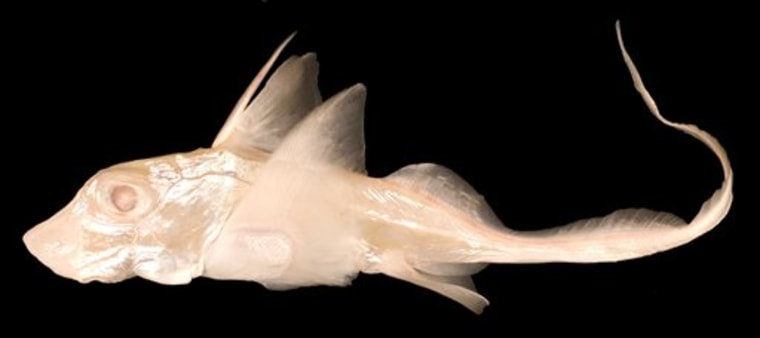There may never be a campaign to save the Puget Sound ratfish; no one really loves the ugly fish with rodent-like front teeth. But when a rare albino ratfish was found during a marine survey this past summer, scientists decided it was time to educate the public about the most abundant fish in local waters.
The cartilaginous cousin of skates and rays is usually brown or black with white spots so it can blend in with the bottom of the sound, where it uses its rat-like teeth to crush clams, crabs and worms scooped up from the sand and mud.
"They're pretty ugly," said Jon Reum, a University of Washington doctoral student who spent his summer working on the marine survey. "They've got this gnarly spine on their backs, they bite, and they're just a pain to work with."
One drizzling and cold day, researchers off Whidbey Island had just pulled up another net loaded with the bottom dwellers and Reum spied the pearly white ratfish. The foot-long female was estimated to be 2 or 3 years old, making her a teenager in the ratfish world.
"This animal would just stand out like a beacon," says UW fisheries professor Ted Pietsch. "I don't know why it wasn't eaten long before."
In his 40-year-career, Pietsch had never seen an albino fish. "To my knowledge, there has never been another albino ratfish described."
The albino ratfish is almost pure white, with pale green eyes, and has a crystalline layer near the surface of its skin that give it a silvery sheen. In the marine environment, few albinos live long enough to pass on the mutant genes that block production of skin pigment.
Reum and his fellow students were stunned.
"Everyone just started chanting and clapping," he says. "It was the most exciting thing."
They put the foot-long female into a bucket to keep her alive.
"People think of Puget Sound and they think of these iconic animals like killer whales and salmon," Reum said. "But when you go by just the numbers, ratfish are by far the most important animal in the ecosystem — yet we know so little about them."
Greg Bargmann, research scientist for the Washington Department of Fish and Wildlife, said any kind of ratfish is rarely seen by humans because they prefer very deep water. They hang out in places with soft, muddy bottoms.
Only net fishermen come across them on a regular basis, but Bargmann said ratfish numbers seem to be growing. Unfortunately, the albino ratfish won't be adding its genes to the species — the night after it was discovered, she flipped out through a gap in the boards covering her bucket and died.
"It was a sad, sad thing," Reum says.
The ratfish is now floating in a jar of alcohol, the only pure albino among the 7.2 million specimens in the UW's fish collection.
